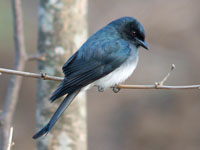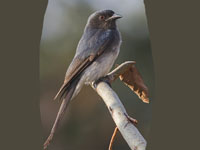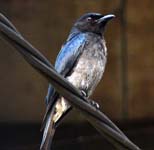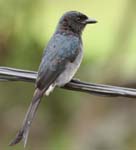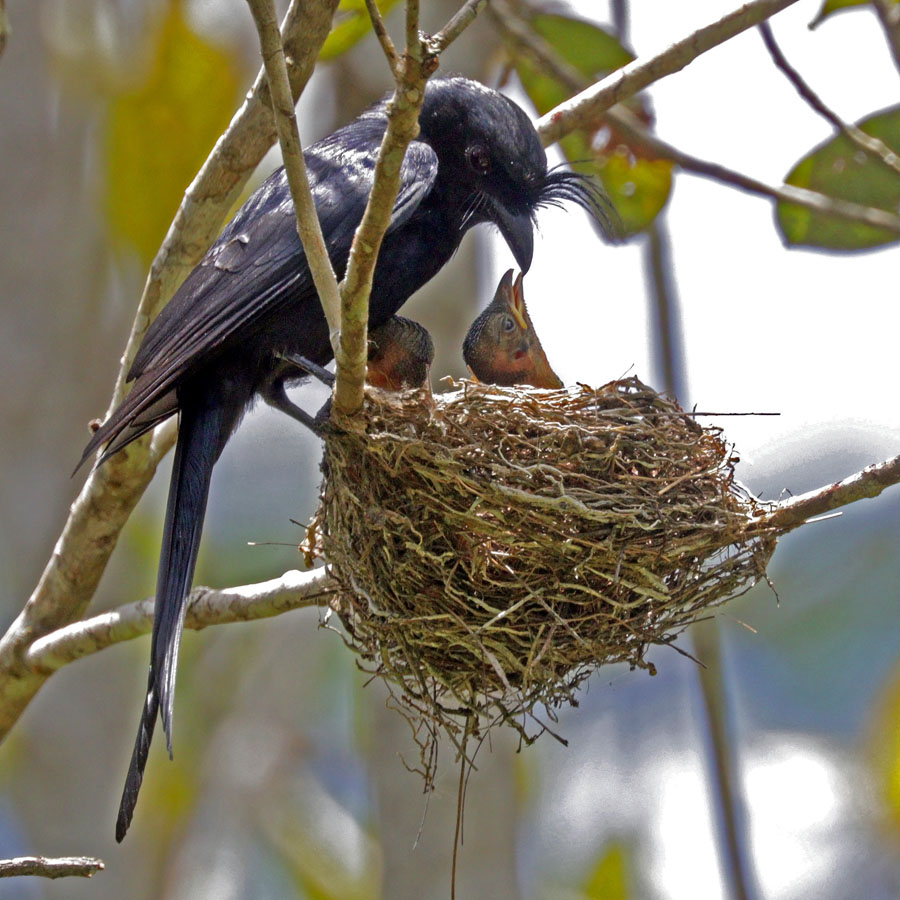The drongos are a family of small passerine birds of the Old World tropics. The name "drongo" comes from the Greek words for "forked tail". Dicrurus, which is the only species in the drongo family Dicruridae, contains about 27 specieis. These insectivorous birds are found usually in open forests or bush. They catch insects in the air like a flycatcher or on the ground. Some will also glean insects from a tree's bark or leaves. Most are black in color; however, the upperparts are usually iridescent and the reflected light can appear blue or greenish-blue. The underparts are much less reflective and are usually black. Some species have small white or bluish dots on their breast which are referred to as spangles. The only exception to all black plumage is the white-bellied drongo which does have varying amounts of white on its underparts.
They have long tails which are almost always forked. The depth of the fork can be used to help identify a species. A few Asian species have elaborate tail decorations such as rackets which can also be used for identification. Drongos have short legs and sit very upright whilst perched, like a shrike. The bills are black and relatively large.
Their nests are cupped shaped usually twice as wide as they are deep. They are made out of small roots, plant stems and other similar plant material. Spider webs may be used to help hold the nest together and sometimes to also help fasten it to the tree, perhaps 5 or 10 meters off the ground, Some nests are so thin on the bottom that the contents are visible. Both parents feed the chicks and in most if not all cases, both parents also build the nests and incubate the eggs. These are aggressive and fearless birds and will attack much larger species if their nest or young are threatened.
Drongos are very vocal, making single note sounds like a whistle or metallic sound, but also making more complex calls. Some drongo species are also excellent mimics. They have been observed mimicing false alarm calls so the could stell another bird's food.
Genus Dicrurus
Balicassiao Dicrurus balicassius
Description: The balicassiao's upperparts, including the forked tail, have a dark blue-green gloss. The legs and bill are black. It has black underparts with some gloss on the belly. The subspecies D. b. mirabilis has a while lower-breast and belly. The balicassiao is about 26 cm long.
Range: Philippines.
Habitat: Moist lowland forest, usually below 1000 meters.
Diet: Insects which it catches in the air.
Conservation status: Least Concern.
Image by:
1) John Gerrard Keulemans 2, 3) Lip_KeeRange: Philippines.
Habitat: Moist lowland forest, usually below 1000 meters.
Diet: Insects which it catches in the air.
Conservation status: Least Concern.
1) Subspecies mirabilis has a white belly 3) Balicassiao chasing green imperial pigeon
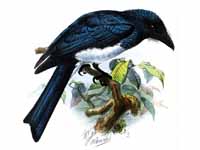
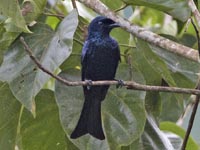

Drongo,_Aldabra Dicrurus aldabranus
Description: The Aldabra drongo has glossy black plumage, heavy bill, a long deeply forked tail, and red eyes. It has black bristles around the base of its black bill which has a slight hook at the end. The Aldabra drongo is about 23 cm long.
Range: Island of Aldabra in the Seychelles.
Habitat: Woodland, dense shrubs, mangroves.
Diet: Catches insects in the air, on a tree, or small invertebrates on the ground.
Conservation status: It is listed as Near Threatened because of its limited range and 1500 population,
Image by: 1) Seychelles_Post 2) Mags49Range: Island of Aldabra in the Seychelles.
Habitat: Woodland, dense shrubs, mangroves.
Diet: Catches insects in the air, on a tree, or small invertebrates on the ground.
Conservation status: It is listed as Near Threatened because of its limited range and 1500 population,
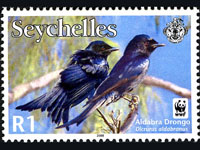

Drongo, Andaman Dicrurus andamanensis
Description: The Andaman drongo has black plumage glossed with green and a deeply forked tail. There are a few black bristles around the base of its heavy black bill. The female is smaller and has a less forked tail. The nominate subspecies is 28 to 29 cm long.
Range: Andaman Islands of the Indian Ocean.
Habitat: Lowland moist forests, especially openings and edges. Vicinity of palm trees.
Diet: Insects which it mainly catches in the air. Will also catch insects on a tree while using the tail for support as a woodpecker does.
Conservation status: Least Concern.
Image by: 1) Shashank Jain 2) Balaji_Venkatesh_Sivaramakrishnan 3) Thomas_abeyRange: Andaman Islands of the Indian Ocean.
Habitat: Lowland moist forests, especially openings and edges. Vicinity of palm trees.
Diet: Insects which it mainly catches in the air. Will also catch insects on a tree while using the tail for support as a woodpecker does.
Conservation status: Least Concern.

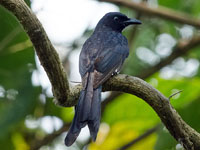
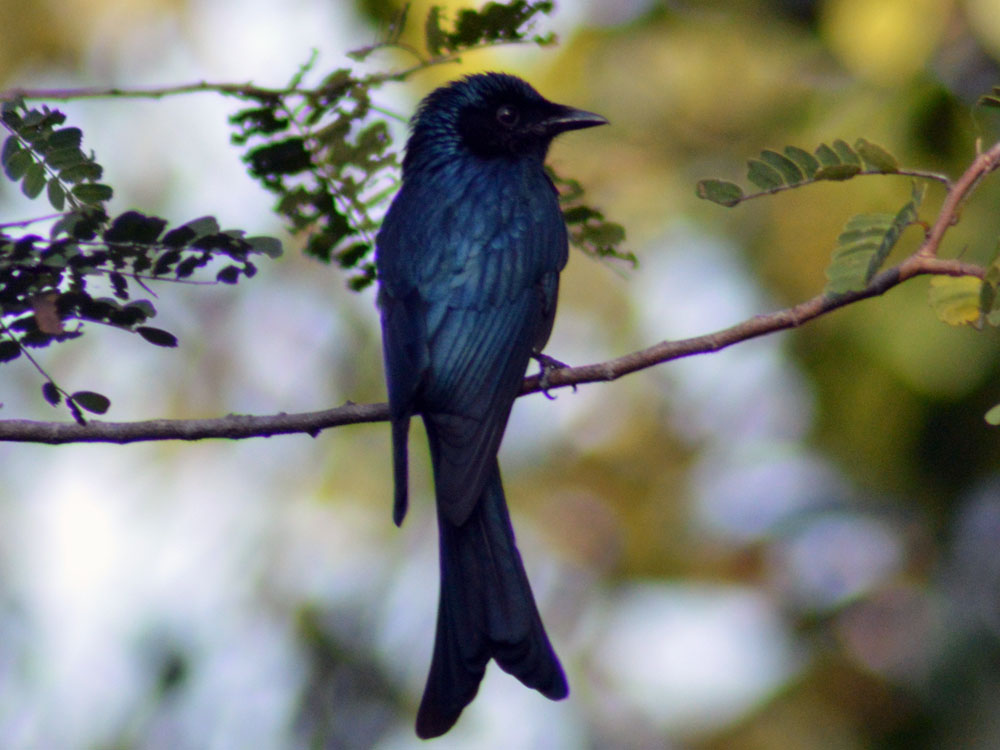
Drongo,_Ashy Dicrurus leucophaeus
Description: The ashy drongo has mainly grey plumage. The darkness of the grey varies by subspecies. The tail is long and deeply forked. The ashy drongo is 25 to 30 cm long.
Range: South and southeast Asia.
Habitat: Montane forests. Northern birds are migratory.
Diet: Insects which it mainly captures in the air.
Conservation status: Least Concern.
Image by: 1) Garima_Bhatia - India 2) Hiyashi_Halso known as 3) Koshy_Koshy 4) Joby_Joseph - India Range: South and southeast Asia.
Habitat: Montane forests. Northern birds are migratory.
Diet: Insects which it mainly captures in the air.
Conservation status: Least Concern.

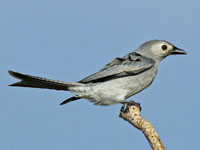
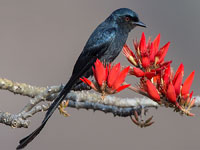
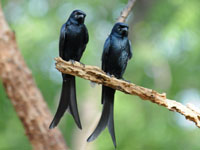
Drongo,_Black Dicrurus macrocercus
Description: The black drongo has black plumage. The long black tail is deeply forked and can distinguish it from other drongo. It is especially aggressive to crows which earns it the name of "king crow". Smaller birds may nest close to it because of its protection.The black drongo is about 28 cm long. The similar bronzed drongo is slightly smaller and its tail is less deeply forked. The hair-crested drongo;s tail curls at the tip.
Range: Southern Asia from Iran to Indonesia
Habitat: Open woodlands, savanna, and agricultural country.
Diet: Mainly insects. Also lizards, small birds. Will frequent fields as they are tilled to find exposed bugs.
Conservation status: Least Concern.
Image by: 1) Lin_Sun_Fong - Taiwan 2) Arthur Chapman 3) Srikaanth_Sekar - India 4) Shantanu_Kuveskar - IndiaRange: Southern Asia from Iran to Indonesia
Habitat: Open woodlands, savanna, and agricultural country.
Diet: Mainly insects. Also lizards, small birds. Will frequent fields as they are tilled to find exposed bugs.
Conservation status: Least Concern.
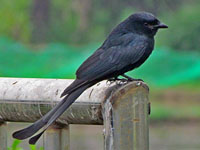
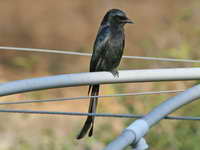
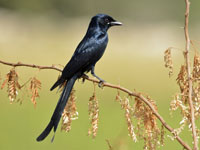

Drongo,_Bronzed Dicrurus aeneus
Description: The bronzed drongo has glossy bluish-black upperparts, lighter underparts, and a velvety black head. The bronzed drongo is about 23 cm long. Its velvety head helps differentiate it from the similar black drongo,
Range: Indian subcontinent to Indonesia, Malaysia.
Habitat: Forest areas, especially broadleafed species.
Diet: Insects which it finds at forest edges.
Conservation status: Least Concern.
Image by: 1) Hiyashi Halso known as 2) Vivekpuliyeri 3, 4) J M Garg - Kolkata, West Bengal, India Range: Indian subcontinent to Indonesia, Malaysia.
Habitat: Forest areas, especially broadleafed species.
Diet: Insects which it finds at forest edges.
Conservation status: Least Concern.

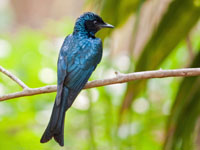
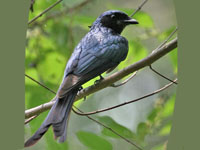
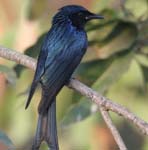
Drongo,_Comoro Dicrurus fuscipennis
Description: The Comoro drongo has glossy black plumage with brown wings and tail. Like most drongos, the tail is forked. It is about 26 cm long.
Range: Comoros islands which are near Madagascar.
Habitat: Moist lowland forests, pastureland, and plantations.
Diet: Fruit and large insects such as cockroaches, grasshoppers, beetles.
Conservation status: It is ESndangered because of habitat loss.
Range: Comoros islands which are near Madagascar.
Habitat: Moist lowland forests, pastureland, and plantations.
Diet: Fruit and large insects such as cockroaches, grasshoppers, beetles.
Conservation status: It is ESndangered because of habitat loss.
Drongo, Crested Dicrurus forficatus
Description: The crested drongo has black plumage with a blue-green sheen. It has a substantial black crest and a forked tail. The male crested drongo is about 28 cm long with the female smaller.
Range: Comoros, Madagascar.
Habitat: Lowland forests, open savannah country.
Diet: Mainly insects, spiders.
Conservation status: Least Concern.
Image by: 1) Frank Vassen - Madagascar 2, 3, 4) Dick Daniels - MadagascarRange: Comoros, Madagascar.
Habitat: Lowland forests, open savannah country.
Diet: Mainly insects, spiders.
Conservation status: Least Concern.
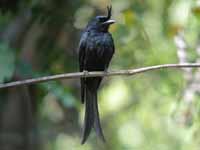
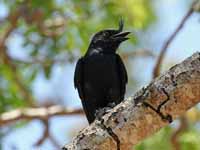

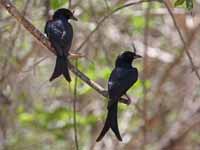
Drongo, Crow-billed Dicrurus annectens
Description: The most distinctive features of the crow-billed drongo is its massive bill and white blotches on underparts. For a drongo, the tail is not strongly forked. The crow-billed drongo is about 29 cm long.
Range: Southeast Asia, Indonesia, Malaysia, Philippines .
Habitat: Lowland forest and mangroves.
Diet: Insects which it catches in the air or on the ground.
Conservation status: Least Concern.
Image by: 1, 2) Lip Kee - IndiaRange: Southeast Asia, Indonesia, Malaysia, Philippines .
Habitat: Lowland forest and mangroves.
Diet: Insects which it catches in the air or on the ground.
Conservation status: Least Concern.
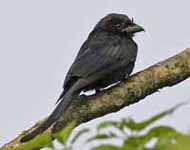
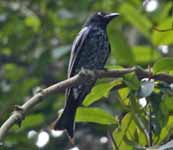
Drongo, Fork-tailed Dicrurus adsimilis
Description: The fork-tailed drongo, also known as the common drongo, has black plumage with a blue-green gloss to the upperparts. The black underparts have little gloss. The tail is more deeply forked than for the average drongo.
Range: Eastern and southern Africa.
Habitat: Open forests or bush.
Diet: Mainly insects which it captures in the air or on the ground. It can even capture swimming fish.
Conservation status: Least Concern.
Image by: 1) Arno Meintjes 2) Lip Kee Yap - Rwanda 3, 4) Dick Daniels - South Africa Range: Eastern and southern Africa.
Habitat: Open forests or bush.
Diet: Mainly insects which it captures in the air or on the ground. It can even capture swimming fish.
Conservation status: Least Concern.
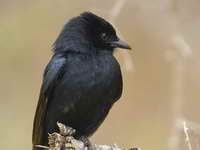
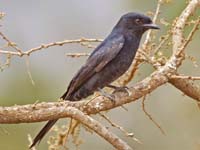

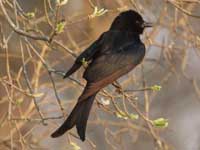
Drongo,_Greater_Racket-tailed Dicrurus paradiseus
Description: The greater racket-tailed drongo is the largest drongo in most of its range. It has black plumage with dark blue glossed upperparts. It has two tail rackets that can be very long and a crest of curled feathers that originate near the base of the bill. The greater racket-tailed drongo length is very variable due to the tail rackets - from 30 to 65 cm. Both pair construct the nest, incubate the eggs, and feed the chicks. The are excellent mimics of other species calls.
Range: Indian Subcontinent, southern China, Southeast Asia.
Habitat: Lowland forests, wooded areas and rather open areas with tall trees.
Diet: Mainly insects. Also small vertebrates, nectar.
Conservation status: Least Concern.
Image by: 1) Praveenp 2) Hiyashi_Halso known as 3) Johnny Wee 4) Lip Kee Yap - SingaporeRange: Indian Subcontinent, southern China, Southeast Asia.
Habitat: Lowland forests, wooded areas and rather open areas with tall trees.
Diet: Mainly insects. Also small vertebrates, nectar.
Conservation status: Least Concern.
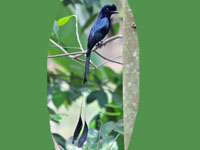
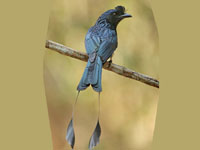
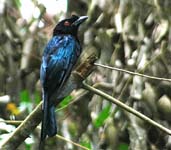
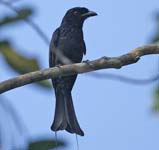
Drongo, Hair-crested Dicrurus hottentottus
Description: The hair-crested drongo has mainly black plumage with a greenish tinge in some places. There are small white dots (spangles) on the breast.The tail is not forked but curls at the tips. There can be hair-like tufts on the head. The similar black drongo has a forked tail. It used to be conspecific with Dicrurus bracteatus, the spangled drongo.
Range: Bangladesh, India, and Bhutan through Indochina to China, Indonesia, and Brunei.
Habitat: Broadleaf evergreen and deciduous forests.
Diet: Insects, possibly nectar.
Conservation status: Least Concern.
Image by: 1) Frankie Chu 2) Ron Knight 3) Vijay_Ismavel 4) Dougjj - SingaporeRange: Bangladesh, India, and Bhutan through Indochina to China, Indonesia, and Brunei.
Habitat: Broadleaf evergreen and deciduous forests.
Diet: Insects, possibly nectar.
Conservation status: Least Concern.
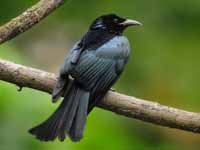


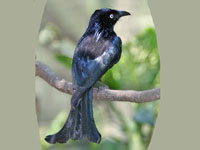
Drongo,_Lesser_Racket-tailed Dicrurus remifer
Description: The lesser racket-tailed drongo has black plumage. The glossy upperparts can appear greenish-blue. It has bristles at the base of the bill, but does not have a crest like the similar greater racket-tailed drongo. It has black underparts with some small white dots on the breast. The tail is square ended and has two long racket shaped feathers. The lesser racket-tailed drongo is about 25 cm long, not including those rackets.
Range: Southeast Asia, Indonesia, Malaysia.
Habitat: Forests, especially edges and clearings.
Diet: Insects, spiders, and some nectar. Catches insects in the air.
Conservation status: Least Concern.
Image by:
1) Francesco Veronesi - Malaysia 2) Melvin Yap 3) Budak - Malaysia Range: Southeast Asia, Indonesia, Malaysia.
Habitat: Forests, especially edges and clearings.
Diet: Insects, spiders, and some nectar. Catches insects in the air.
Conservation status: Least Concern.
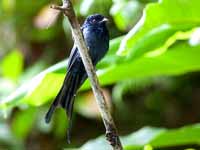
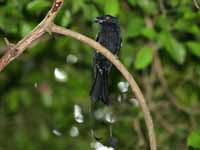
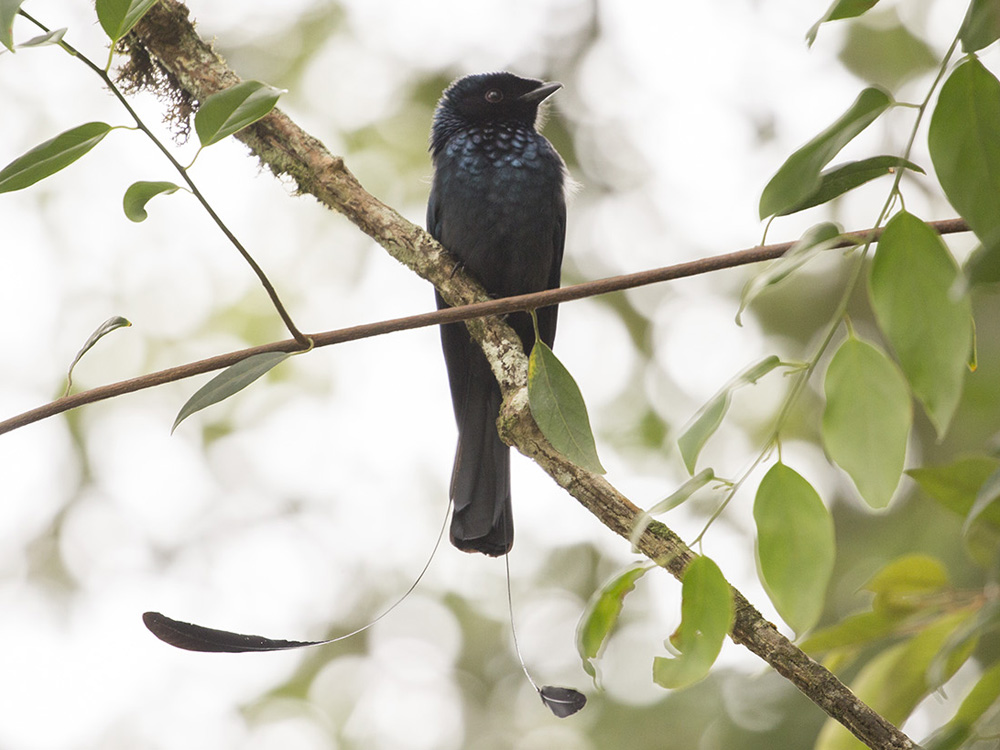
Drongo, Mayotte Dicrurus waldenii
Description: The Mayotte drongo has black plumage with a greenish-blue gloss to the upperparts. The long tail is deeply forked. The Mayotte drongo is up to 38 cm long.
Range: Mayotte (island north of Madagascar.
Habitat: Forests, mangroves, plantations.
Diet: Mainly insects.
Conservation status: It is listed as Vulnerable due to habitat loss.
Image by:
1) John Gerrard Keulemans Range: Mayotte (island north of Madagascar.
Habitat: Forests, mangroves, plantations.
Diet: Mainly insects.
Conservation status: It is listed as Vulnerable due to habitat loss.
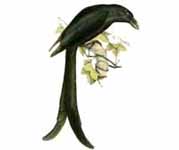
Drongo,_Ribbon-tailed Dicrurus megarhynchus
Description: The ribbon-tailed drongo, also known as the paradise drongo, has black plumage with a dark blue gloss to the upperparts. The outer tail feathers are very elongated similar to racket-tailed drongos, but these outer shafts are wider, hence the name "ribbon". The ribbon-tailed drongo is up to 56 cm long, including its long tail.
Range: New Ireland in the Bismarck Archipelago (near New Guinea).
Habitat: Various wooded sections of the island.
Diet: Insects which it catches by flying or from leaves and on branches of a tree. Also small vertebrates.
Conservation status: It is listed as Near Threatened because of its limited ranged. It natural habit is being logged and the population declining, but there are still substantial numbers.
Image by: 1) Katerina_TvardikovaRange: New Ireland in the Bismarck Archipelago (near New Guinea).
Habitat: Various wooded sections of the island.
Diet: Insects which it catches by flying or from leaves and on branches of a tree. Also small vertebrates.
Conservation status: It is listed as Near Threatened because of its limited ranged. It natural habit is being logged and the population declining, but there are still substantial numbers.
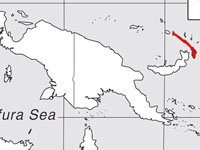
Drongo,_Shining Dicrurus atripennis
Description: The shining drongo has shining black plumage which appears blue or even green in good light. The head usually has little iridescent reflection, especially the forehead due to bristles and thus appears black. The underparts are also less reflective. The shining drongo is up to 24 cm long.
Range: Central Africa, mainly on the west.
Habitat: Mature forests
Diet: Insects which it capture in flight or by gleaning on trees.
Conservation status: Least Concern.
Range: Central Africa, mainly on the west.
Habitat: Mature forests
Diet: Insects which it capture in flight or by gleaning on trees.
Conservation status: Least Concern.
Drongo,_Spangled Dicrurus bracteatus
Description: The spangled drongo has black plumage which is iridescent with blue and purple highlights. There are small white spots on the breast plus some on the necks-sides and forehead. It has a slightly forked tail. It is a good mimic of sounds. The spangled drongo is about 30 cm long with the female a little less.
Range: Australia where it is the only drongo.
Habitat: Varied.
Diet: Insects and small vertebrates.
Conservation status: Least Concern.
Image by: 1) David Cook 2) Glen Fergus 3) JJ_Harrison 4) Ian_SuttonRange: Australia where it is the only drongo.
Habitat: Varied.
Diet: Insects and small vertebrates.
Conservation status: Least Concern.
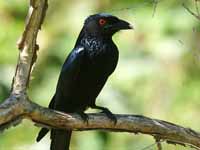
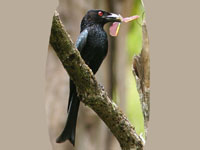
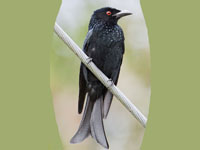
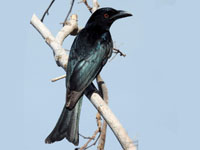
The square-tailed drongo has been split into there separate species: common square-tailed drongo, Sharpe's drongo, and the weste4rn square-tailed drongo. These three species are treated next.
Drongo, Common Square-tailed Dicrurus ludwigii
Description: The common square-tailed drongo has glossy greenish-black plumage, duller wings, a black bill, and red eyes. Female less glossy. The end of their tail is square, that is, not notched. The common square-tailed drongo is small for its genus, about 19 cm long. The similarsimilar Sharpe's drongo has blue-glossed plumage instead of green glossed.
Range: Southern Africa.
Habitat: Forests and dense bush.
Diet: Insects which are caught in the air or on the ground.
Conservation status: Least Concern.
Image by: 1) Dick Daniels near Kruger National Park, South Africa 2) Alan Manson 3) Charles_Gates - South AfricaRange: Southern Africa.
Habitat: Forests and dense bush.
Diet: Insects which are caught in the air or on the ground.
Conservation status: Least Concern.
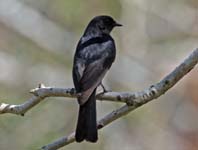

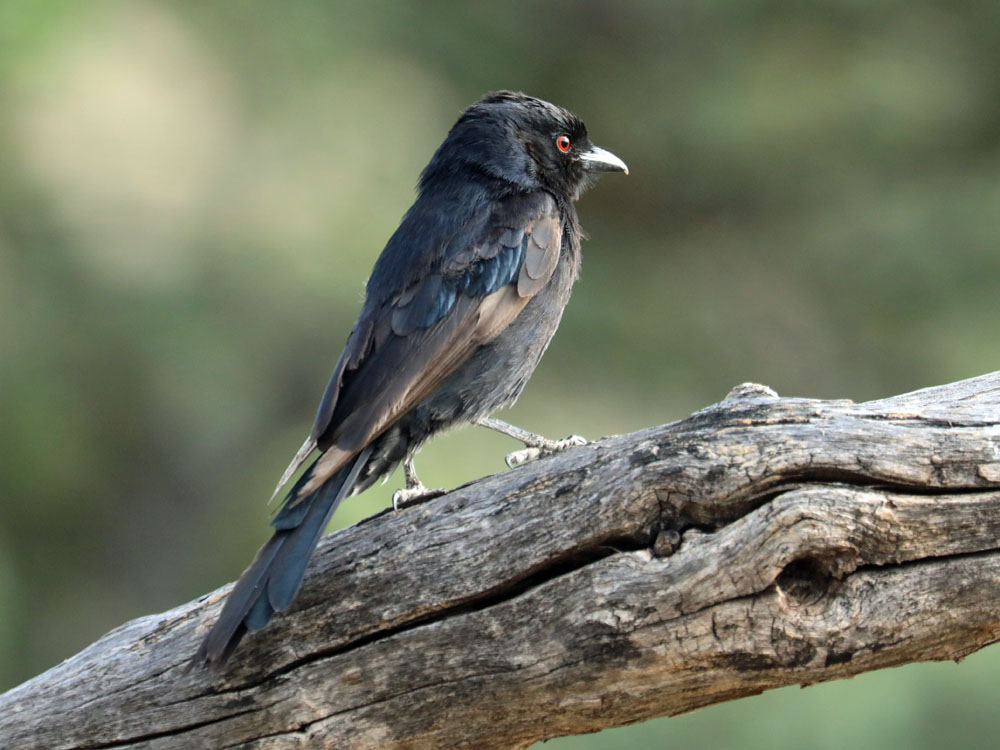
Drongo, Sharpe's Dicrurus sharpei
Description: The Sharpe's drongo has glossy blue-black plumage, duller wings,a black bill, and red eyes. Female less glossy. The end of their tail is square, that is, not notched. The Sharpe's is small for its genus, about 19 cm long. The similar western square-tailed drongo has a larger bill.
Range: Eastern Nigeria, Cameroon, Equatorial Guinea, Gabon
Habitat: Forests and dense bush.
Diet: Insects which are caught in the air or on the ground.
Conservation status: Least Concern.
Image by: 1, 2) Lip Kee - EthiopiaRange: Eastern Nigeria, Cameroon, Equatorial Guinea, Gabon
Habitat: Forests and dense bush.
Diet: Insects which are caught in the air or on the ground.
Conservation status: Least Concern.
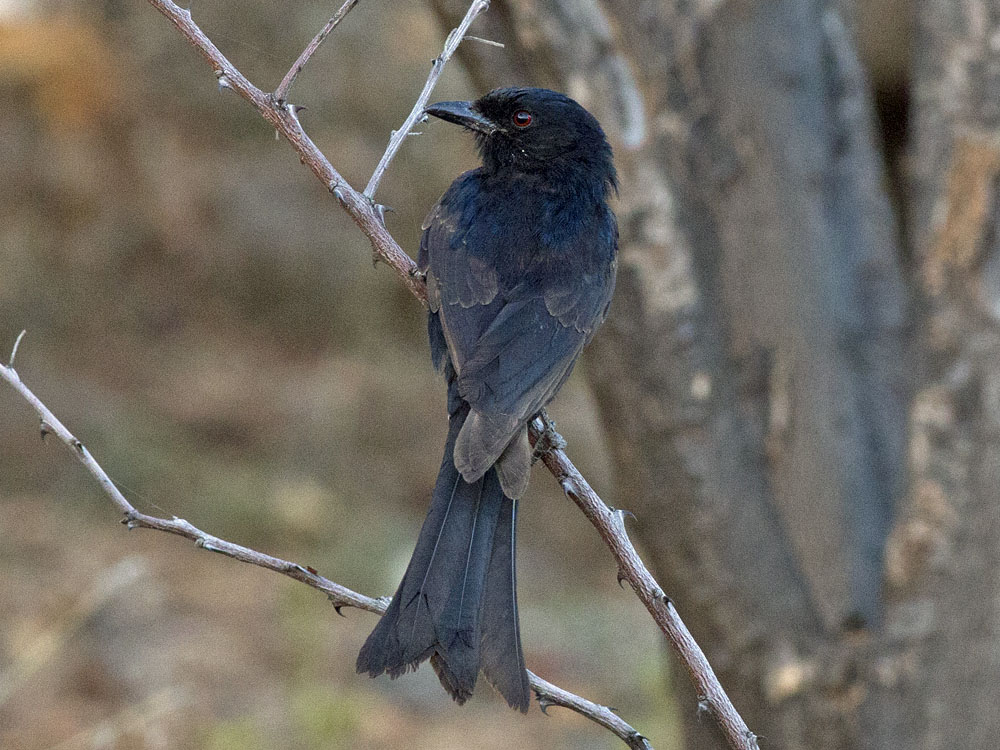
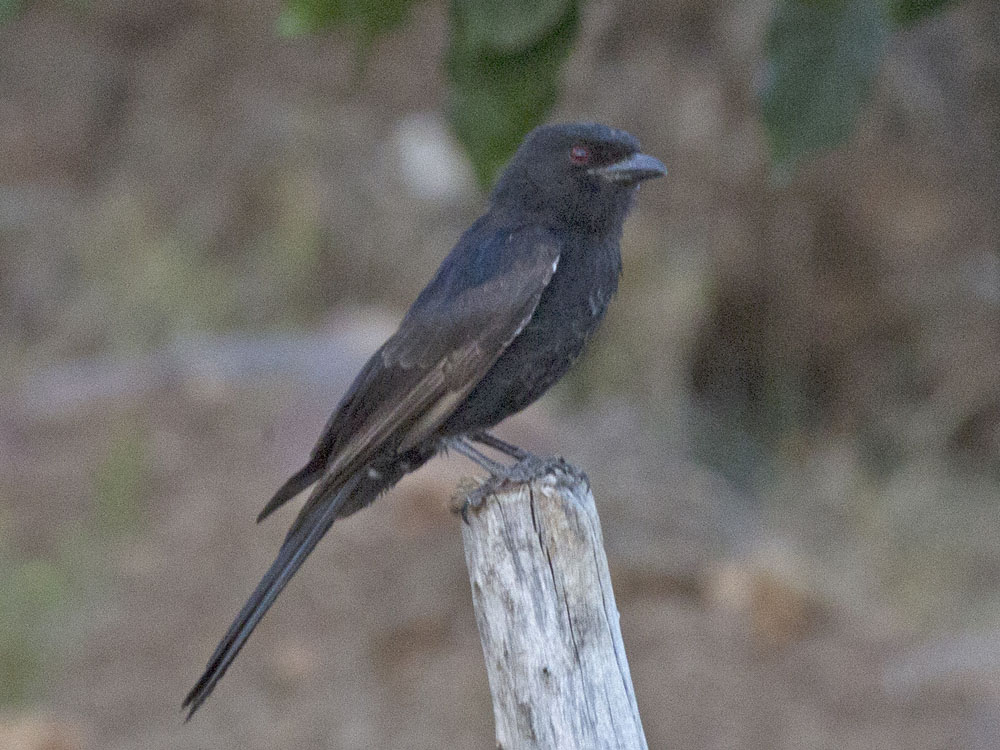
Drongo, Western Square-tailed Dicrurus occidentalis
Description: The westerrn square-tailed drongo has glossy black plumage, duller wings, a black bill, and red eyes. Female less glossy. The end of their tail is square, that is, not notched. The square-tailed drongo is small for its genus, about 19 cm long. The similar Sharpe's drongo has a smaller bill.
Range: Western Africa - Senegal and Gambia east to Nigeria.
Habitat: Forests and dense bush.
Diet: Insects which are caught in the air or on the ground.
Conservation status: Least Concern.
Image by: 1) Dave_Curtis - GhanaRange: Western Africa - Senegal and Gambia east to Nigeria.
Habitat: Forests and dense bush.
Diet: Insects which are caught in the air or on the ground.
Conservation status: Least Concern.
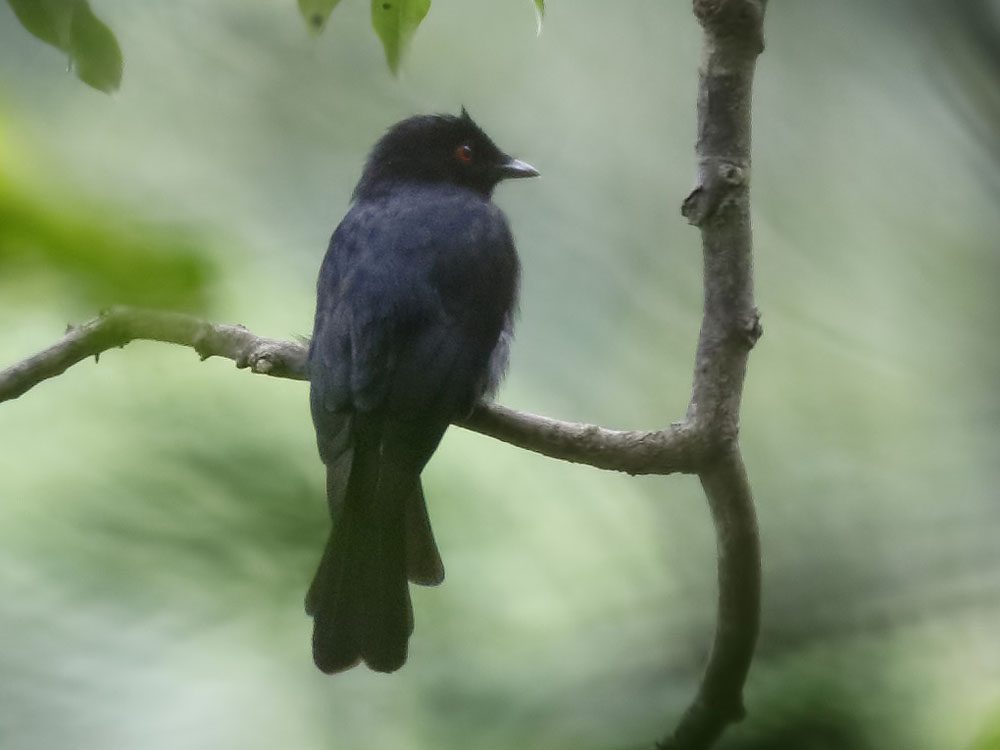
Drongo,_Sumatran Dicrurus sumatranus
Description: The Sumatran drongo has glossy black upperparts and black underparts with some blue spangles on the breast. It has a square tail. The Sumatran drongo is about 20 cm long.
Range: Sumatra in Indonesia.
Habitat: Lowland forests.
Diet: Insects which it catches in flight, on tree trucks, or gleaned from leaves.
Conservation status: It is listed as Near Threatened because of habitat loss.
Range: Sumatra in Indonesia.
Habitat: Lowland forests.
Diet: Insects which it catches in flight, on tree trucks, or gleaned from leaves.
Conservation status: It is listed as Near Threatened because of habitat loss.
Drongo, Sri Lanka Dicrurus lophorinus
Description: The Sri Lanka drongo has black plumage with a blue or greenish-blue gloss to the upperparts. There are bristles at the base of the bill, blue spangles on the breast, and a deeply forked tail.
Range: Sri Lanka.
Habitat: Humid forests with dense undergrowth.
Diet: Insects which it captures in the air.
Conservation status: Least Concern.
Image by: 1) Rehman_Abubakr 2) John KeulemansRange: Sri Lanka.
Habitat: Humid forests with dense undergrowth.
Diet: Insects which it captures in the air.
Conservation status: Least Concern.
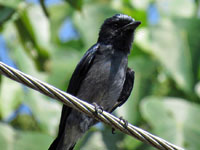
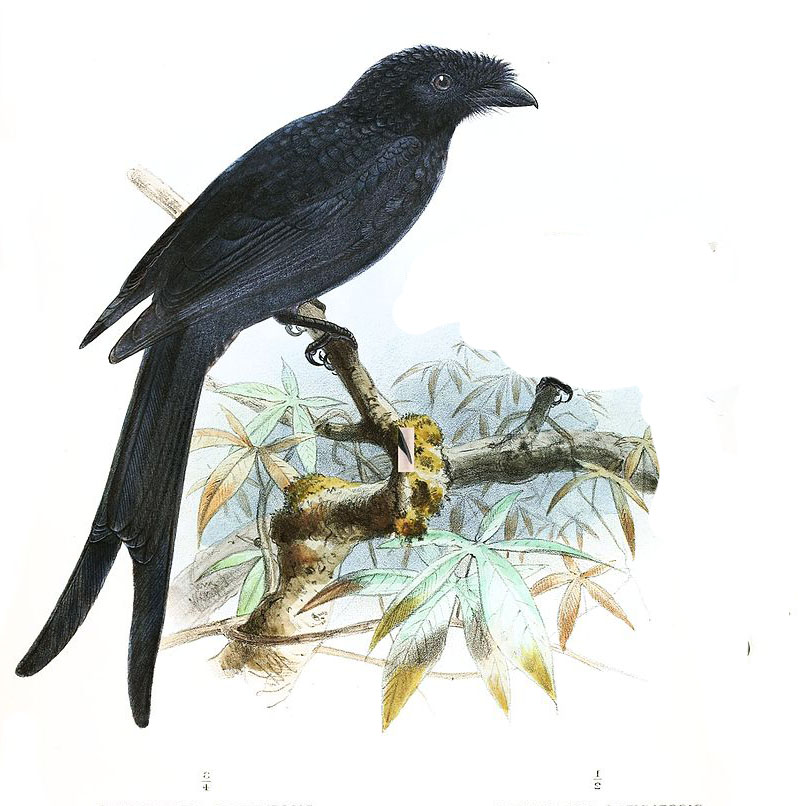
Drongo, Sulawesi Dicrurus montanus
Description: The Sulawesi drongo has iridescent bluish-black upperparts, black underparts with pale bluish spangles, and a forked tail. It is about 25 cm long. The similar hair-crested drongo does not have a forked tail.
Range: Sulawesi (Indonesia).
Habitat: Hilly or montane wooded areas.
Diet: Insects.
Conservation status: Least Concern.
Image by:
1) Francesco VeronesiRange: Sulawesi (Indonesia).
Habitat: Hilly or montane wooded areas.
Diet: Insects.
Conservation status: Least Concern.
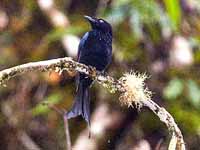
Drongo,_Tablas Dicrurus menagei
Description: The Tablas drongo has mainly black plumage with a greenish tinge in some places. There are small white dots (spangles) on the breast.The tail is long, deeply forked and curls at the tips. There can be hair-like tufts on the head. It is about 35 cm long. The Tablas drongo was formerly considered conspecific with the hair-crested drongo
Range: Tablas island of the Philippines.
Habitat: Montane forests and woodlands. Does not like to be in the open.
Diet: Insects.
Conservation status: It is listed as Endangered because of its small range has had extensive logging.
Range: Tablas island of the Philippines.
Habitat: Montane forests and woodlands. Does not like to be in the open.
Diet: Insects.
Conservation status: It is listed as Endangered because of its small range has had extensive logging.
Drongo, Velvet-mantled Dicrurus modestus
Description: The velvet-mantled drongo has mainly glossy black upperparts, but the unglossed mantle resembles velvet. The underparts are also unglossed black. It has a long and forked tail. The velvet-mantled drongo is from 24 to 28 cm long.
Range: Central Africa, mainly in the west.
Habitat: Areas with large trees including forests and plantations.
Diet: Insects which are mainly caught in the air, but also in trees and on the ground.
Conservation status: Least Concern.
Image by:
1) Francesco Veronesi - Ghana 2) Lip Kee - RwandaRange: Central Africa, mainly in the west.
Habitat: Areas with large trees including forests and plantations.
Diet: Insects which are mainly caught in the air, but also in trees and on the ground.
Conservation status: Least Concern.
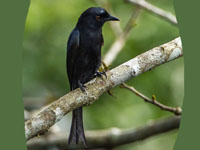

Drongo, Wallacean Dicrurus densus
Description: The Wallacean drongo has mainly black plumage. It has has an unglossed head and mantle, but the rest of the upperparts are glossed. The underparts are also unglossed black, except the under-tail does have some gloss. The tail is curved at the sides and has a slight fork in the center of its tip, although some subspecies have a relatively unforked tail. It was formerly considered conspecific with the hair-crested drongo.
Range: Indonesia and Timor.
Habitat: Moist lowland or montane forests; also mangroves.
Diet: Insects.
Conservation status: Least Concern.
Image by:
1) Ron Knight - West Timor Range: Indonesia and Timor.
Habitat: Moist lowland or montane forests; also mangroves.
Diet: Insects.
Conservation status: Least Concern.
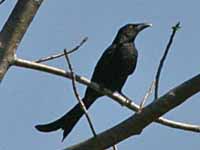
Drongo,_White-bellied Dicrurus caerulescens
Description: The white-bellied drongo has black upperparts with a blue gloss, except for the forehead and lores that are unglossed. It has a long and forked black tail. The throat and upperparts are black. The lower breast and belly have variable amounts of white depending upon the subspecies. The subspecies in Sri Lanka has its white restricted to the vent area. The only other species it might be confused with is the black drongo as the juvenile white-bellied drongos are almost entirely black. The white-bellied drongo is about 24 cm long.
Range: Indian Subcontinent including Sri Lanka.
Habitat: Open woodlands, gardens and plantations.
Diet: Insects; also nectar. It catches insects in flight.
Conservation status: Least Concern.
Image by: 1) Eric_Gropp - southern India 2) Dibyendu_Ash - India 3) Hafiz Issadeen 4) Thimindu - Colombo, Sri Lanka Range: Indian Subcontinent including Sri Lanka.
Habitat: Open woodlands, gardens and plantations.
Diet: Insects; also nectar. It catches insects in flight.
Conservation status: Least Concern.
